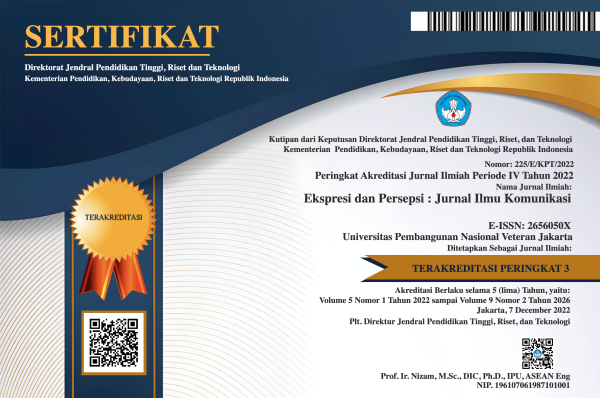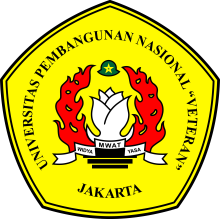Variations of Elderly Communication: Conversations and Conformity with Children, In-Laws, and Grandchildren
DOI:
https://doi.org/10.33822/jep.v8i2.9490Keywords:
elderly, conversations, conformity, communication, intergenerationAbstract
An aging population is a global demographic trend that creates social problems. Whether they live with family members or apart from them, elderly individuals often experience potential conflict in intergenerational communication. This research aims to find out the family communication patterns of the elderly in their communication with children, in-laws, and grandchildren. The Revised Family Communication Pattern Instrument (Parent Version) or RFCP-PV was used to measure family communication patterns that link conversation orientation and conformity orientation. This study used quantitative descriptive methods on 94 elderly people in Bandung City. This elderly group consists of Seroja Cinambo Elderly, Bahagia Antapani Elderly, Sibulan Sukajadi Elderly, and Sicetar Ujung Berung Elderly. The elderly who were used as respondents were elderly people who were under the auspices of Indonesia Friendly Elderly (IRL), West Java. The elderly were asked to complete a questionnaire regarding family communication patterns and provide an overview of variations in their communication with their families. The results indicate diverse patterns in how elderly individuals communicate with their children, in-laws, and grandchildren, particularly regarding their orientation toward conversation and conformity.
References
Acar, A. B. (2014). Do intrinsic and extrinsic motivation factors differ for Generation X and Generation Y? International Journal of Business & Social Science, 5(5), 12–21. https://doi.org/10.30845/ijbss
Andrea, B., Gabriella, H. C., & Tímea, J. (2016). Y and Z generations at workplaces. Journal of Competitiveness, 8(3), 90–106. https://doi.org/10.7441/joc.2016.03.06
Branje, S. (2008). Conflict management in mother-daughter interactions in early adolescence. Behaviour, 145 (11) 1627–1651. https://doi.org/10.1163/156853908786131315
Callanan, G. A. & Greenhaus, J. H. (2008). The Baby Boom Generation and Career Management: A Call to Action, 10(1). https://doi.org/10.1177/1523422307310113
Campbell, W. K., Campbell, S. M., Siedor, L. E., & Twenge, J. M. (2015). Generational differences are real and useful. Industrial and Organizational Psychology, 8(3), 324–408. https://doi.org/10.1017/iop.2015.43
Choi, L. (2022). Intergenerational family Conflict Among Asian American Families;An Exploration Of Its Dynamics, Effects, and Therapeutic Interventions. https://digitalcommons.pepperdine.edu/cgi/viewcontent.cgi?article=2274&context=etd Child_Communication_and_Parental_Involvement_in_Latino_Adolescents
Davidson, T. M., & Cardemil, E. V. (2009). Parent-child communication and parental involvement in latino adolescents. Journal of Early Adolescence, 29(1), 99–121. https://doi.org/10.1177/0272431608324480
Dobiesz A.Ż,e Chomątowska, B. (2014). Pokolenie ,,Z” na rynku pracy – wyzwania dla zarządzania zasobami ludzkimi. The Challenge for Human Resource Management, 405–415. https://doi.org/10.15611/pn.2014.350.36
Dolot, A. (2018). The characteristics of Generation Z. E-Mentor, (74), 44–50. https://doi.org/10.15219/em74.1351
Fadlurrohim, I., Husein, A., Yulia, L., Wibowo, H., & Raharjo, S. T. (2020). Memahami Perkembangan Anak Generasi Alfa Di Era Industri 4.0. Focus : Jurnal Pekerjaan Sosial, 2(2), 178. https://doi.org/10.24198/focus.v2i2.26235
Fauziningtyas, R., Indarwati, R., Alfriani, D., Haryanto, J., Ulfiana, E., Efendi, F., & Abdullah, K. L. (2019). The experiences of grandparents raising grandchildren in Indonesia. Working with Older People, 23(1), 17–26. https://doi.org/10.1108/WWOP-10-2018-0019
Fitzpatrick, M. A., & Rtichie, L. D. (1993). Communication theory and the family. In P. G. Boss, W.J. Doherty, W.R. Schumm, & S. K. Steinmetz (Eds.), Sourcebook of family theories and methods: A contextual approach. New York: Plenum Press.
Ganasen, K. A., Parker, S., Hugo, C. J., Stein, D. J., Emsley, R. A., & Seedat, S. (2008). Mental health literacy: Focus on developing countries. African Journal of Psychiatry (South Africa), 11(1), 23–28. https://doi.org/10.4314/ajpsy.v11i1.30251
Glen, H. S. (2003). Theories Of Family Relationships and a Family Relationships Theoretical Model. (1st Edition, Ed.). Lawrence Erlbaum Associates. https://www.taylorfrancis.com/chapters/edit/10.4324/9781410609564-7/theories-family-relationships-family-relationships-theoretical-model-glen-stamp
Guo, L., Zhang, J., Ma, W., Sha, X., Yi, X., Zhang, B., Wang, C. & Wang, S. (2015). Offspring caregivers’ depression affected by intergenerational disagreements on preferred living arrangement for the elderly: A phenomena with Chinese characteristic. https://doi.org/10.1016/j.archger.2015.08.013
Hatfield, S. L. (2002). Understanding the four generations to enhance workplace management.
Koerner, A. F., Schrodt, P., & Fitzpatrick, M. A. (2017). Family communication: Patterns theory a grand theory of family communication. In Engaging Theories in Family Communication: Multiple Perspectives. Taylor and Francis, 142–153. https://doi.org/https://doi.org/10.4324/9781315204321
Koerner, A. F., & Fitzpatrick, M. A. (1997). Family type and conflict: The impact of conversation orientation and conformity orientation on conflict in the family. Communication Studies, 48(1), 59–75. https://doi.org/10.1080/10510979709368491
Koerner, A. F., & Fitzpatrick, M. A. (2002a). Chapter 2: Understanding Family Communication Patterns and Family Functioning: The Roles of Conversation Orientation and Conformity Orientation. Communication Yearbook, 26(1), 36–68. https://doi.org/10.1207/s15567419cy2601_2
Koerner, A. F., & Fitzpatrick, M. A. (2002b). Toward a theory of family communication. Communication Theory, 12(1), 70–91. https://doi.org/10.1111/j.1468-2885.2002.tb00260.x
Lyons, A., Alba, B., Heywood, W., Fileborn, B., Minichiello, V., Barrett, C., Hinchliff, S., Malta, S. & Dow, B. (2018). Experiences of ageism and the mental health of older adults. Aging Ment Health, Nov 22(11), 1456–1464. https://doi.org/10.1080/13607863.2017.1364347
McLeod, J. M. & Chaffee, S. H. (1972). The Contraction of Social Reality. In J. Tedeschi. (Ed)., The Social Influence Processes. Chicago: Aldine-Artherton.
Mulyadi, M. B. (2019). Kesenjangan Karakteristik antar Generasi dalam Pendidikan di Era Revolusi Indutri 4.0. In Conference: Proceeding Connect 3rd: FKIP UNSUR.
Benly, N. E., Mansyarif, R., Asma, W. O. S., Husunu, W. O. S. F., Hastuti, A.S., Bahar, N., Anggraini, A. & Sutriawati. (2022). Pelayanan Pemeriksaan Kesehatan Gratis Pada Lansia Di Wilayah Kerja Puskesmas Batalaiworu. J-ABDI: Jurnal Pengabdian Kepada Masyarakat, 1(12), 3495–3502.
Nita, V., Astuti, T., Khasanah, N., & Nugrahaningtyas. (2019). Pemeriksaan Kesehatan Pada Lansia Di Dusun Ringinsari Bokoharjo Prambanan Sleman Daerah Istimewa Yogyakarta. Jurnal Pengabdian Masyarakat Karya Husada, 1(2), 36–41. P ISSN 2654-7716/eISSN 2656-4211
Ochoa, G. M., Lopez, E. E., & Emler, N. P. (2007). Adjustment problems in the family and school contexts, attitude towards authority, and violent behavior at school in adolescence. Libra Publishers, Inc., 3089C Clairemont Dr., PMB 383, San Diego, CA 92117. 779-794.
Pepe, C. K. (2017). Dukungan Sosial Keluarga. Konsep Dan Proses Keperawatan Keluarga, 7(1), 26.https://books.google.co.id/books?id=Ta3GAwAAQBAJ&pg=PA26&dq=dukungan+keluarga+adalah&hl=id&sa=X&ved=0ahUKEwj0cOwxu3lAhVaeH0KHcSUDt0Q6AEIQjAE#v=onepage&q&f=false
Ritchie, L. D., & Fitzpatrick, M. A. (1990). Family communication patterns: Measuring interpersonal perceptions of interpersonal relationships. Communication Research., 523–544. https://doi.org/https://doi.org/10.1177/009365090017004007
Silalahi, U. (2012). Metode Penelitian Sosial. PT. Refika Aditama.
Sillars, A., Holman, A. J., Richards, A., Jacobs, K. A., Koerner, A., & Reynolds-Dyk, A. (2014). Conversation and Conformity Orientations as Predictors of Observed Conflict Tactics in Parent-Adolescent Discussions. Journal of Family Communication, 14(1), 16–31. https://doi.org/10.1080/15267431.2013.857327
Socha, Thomas, J. & Stamp, G. H. (1996). Parents, Children, and Communication. Frontiers of Theory and Research. New York: Routledge. https://doi.org/https://doi.org/10.4324/9780203812013
Valentine, D. B., & Powers, T. L. (2013). Generation Y values and lifestyle segments. Journal of Consumer Marketing, 30(7), 597–606. https://doi.org/https://doi.org/10.1108/JCM-07-2013-0650
Widyaningrum, G. L. (2020). WHO Tetapkan Covid-19 sebagai Pandemi Global, Apa Maksudnya? https://nationalgeographic.grid.id/read/132059249/who-tetapkan-covid-19-sebagai-pandemi-global-apa-maksudnya.
World Health Organization. (2020). Retrieved July 15, 2020. https://www.who.int/emergencies/diseases/novel-coronavirus-2019
Zapf, H., Boettcher, J., Haukeland, Y., Orm, S., Coslar, S., Wiegand-Grefe, S., & Fjermestad, K. (2023). A Systematic Review of Parent–Child Communication Measures: Instruments and Their Psychometric Properties. Clinical Child and Family Psychology Review, 26(1), 121–142. https://doi.org/10.1007/s10567-022-00414-3
Zhong, S., Lee, C., Foster, M. J. & Bian, J. (2020). Intergenerational communities: A systematic literature review of intergenerational interactions and older adults’ health-related outcomes. Soc Sci Med, 264 (November 2020). https://doi.org/10.1016/j.socscimed.2020.113374
Zufar, Z. & Thaariq, A. (2023). Learner Characteristics based on Generational Differences. Jurnal Pendidikan Humaniora, 11(1), 10–20. https://doi.org/10.17977/um011v11i12023p10-20
Downloads
Published
Issue
Section
License
Copyright (c) 2025 Yulianti, Dian Widyaputrisy, Stephani Hamdan

This work is licensed under a Creative Commons Attribution-NonCommercial 4.0 International License.














